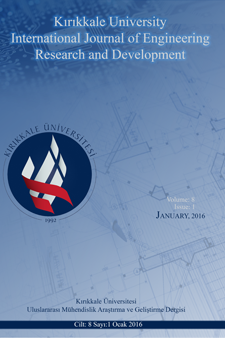Design, Manufacturing and Testing of a Stirling Engine with Slider-Crank Mechanism
Design, Manufacturing and Testing of a Stirling Engine with Slider-Crank Mechanism
Stirling engines, Slider-crank mechanism Engine design and manufacturing, Stirling engine testing,
___
- Brey, H. D., Rinia, H., Weenen, F. L.V. (1947). Fundamentals for the development of the Philips air engine, Philips Technical Review, 9(4):97-104.
- Çınar, C., Aksoy, F., Erol, D. (2012). The effect of displacer material on the performance of a low temperature differential Stirling engine, International Journal of Energy Research, 36:911-917.
- Erol, D., Yaman, H. and Doğan, B. (2017). A review development of rhombic drive mechanism used in the Stirling engines. Renewable and Sustainable Energy Reviews, 78:1044-1067.
- Finkelstein, T. and Organ, A. J., Air engines the history science and reality of the perfect engine. The American Society of Mechanical Engineers, New York, 2004.
- Gielen, D., Boshell, F., Saygin, D., Bazilian, M.D. and Wagner, N. (2019). The role of renewable energy in the global energy transformation, Energy Strategy Reviews, 24:38-50.
- Guelpa, E., Bischi, A., Verda, V., Chertkov, M., Lund, H. (2019). Towards future infrastructures for sustainable multi-energy systems: A review, Energy, 184:2-21.
- Hansen, K., Mathiesen, B.V., Skov, I. R. (2019). Full energy system transition towards 100% renewable energy in Germany in 2050, Renewable and Sustainable Energy Reviews, 102:1-13.
- Krakowski, V., Assoumou, E., Mazauric, V. and Maïzi, N. (2016). Feasible path toward 40–100% renewable energy shares for power supply in France by 2050: A prospective analysis, Applied Energy, 171:501–522.
- Meijer, R. J. (1965). Philips Stirling engine activities, SAE Technical Paper (No. 650004).
- Lin, B., Zhu, J. (2019). Determinants of renewable energy technological innovation in China under CO2 emissions constraint, Journal of Environmental Management, 247:662-671.
- Nathaniel, S. P., Iheonu, C. O. (2019). Carbon dioxide abatement in Africa: The role of renewable and non-renewable energy consumption. Science of The Total Environment, 679:337-345.
- Organ, A. J., (2014). Stirling cycle engines inner workings and design. John Wiley and Sons, Ltd, (ISBN:9781118818435).
- Ozcan, M. (2018). The role of renewables in increasing Turkey's self-sufficiency in electrical energy. Renewable and Sustainable Energy Reviews, 82, 2629-2639.
- Rinia, H., Pre, F. K. D. (1946). Air engines, Philips Technical Review, 8:129-136.
- Stirling, R., Stirling Air Engine and The Heat Regenarator, Patent no 4081, 1816.
- Urieli, I. and Berchowitz, D. M. (1984). Stirling Cycle Engine Analysis. (1. Edition). Bristol: Adam Hilger.
- Weenen, F. L. V. 1947. “The Construction of the Philips air engine”, Philips Technical Review, 9(5):125-134.
- Yayın Aralığı: 2
- Başlangıç: 2009
- Yayıncı: -
Ömer AKTÜRK, Beste ÇAĞDAŞ TUNALI
Atık Mermerlerin Parke Taşlarında İnce Agrega Olarak Kullanılabilirliğinin İncelenmesi
Melih Naci AĞAOĞLU, Ezgi ÇEVİREN, Erdinç Halis ALAKARA
Yenilenebilir Hibrit Enerji Santrali Uygulamasında Tesis Yer Seçimi
Mert KARA, Yiğitcan ERCAN, Rabia YUMUŞAK, Ahmet CÜREBAL, Tamer EREN
Erdinç Halis ALAKARA, Melih Naci AĞAOĞLU
Türkiye’de Kullanılan Deprem Yönetmeliklerinin Özellikleri ve Deprem Hesabının Değişimi
Kasis Profilinin Pasif Süspansiyon Sistemli Çeyrek Araba Modeli Kullanılarak Sürüş Konforuna Etkisi
